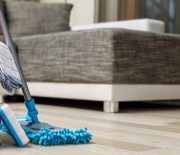Last update: 1 year ago

Oh, the bathtub – where you wash away your worries until you see the dirt. Suddenly, your private paradise feels scary. Do not be afraid! If you’re familiar with the process, you’ll quickly get rid of those bathtub blues. Let’s eliminate the stress and restore your tub to its shining state without any effort!
What is the easiest way to clean a bathtub?
Just choose the right cleaner. For a natural scrub, mix up some baking soda and vinegar. If you’re after convenience, grab a commercial cleaner instead. Dish soap and warm water work wonders for regular upkeep, while a paste of hydrogen peroxide and baking soda is your go-to for those tough, stubborn stains.
Natural cleaning methods
Natural cleaners are a great way to keep your bathtub sparkling without harsh chemicals. They’re eco-friendly and safe. Moreover, they are usually made from items you already have around the house.
- Baking soda paste – Mix baking soda and water in a bowl until you get a paste. This gentle scrub is perfect for tackling soap scum and grime in your tub.
- Vinegar spray – Combine equal parts vinegar and water in a spray bottle. Apply it to your bathtub. Apply it to your bathtub. It will eliminate bacteria and dissolve the sticky residue. It’s similar to a natural germ killer!
- Vinegar and baking soda – Great for tough soap scum. Mix equal parts vinegar and warm water. Then, spray the bathtub liberally. Let it sit for approximately one hour. Then, use a baking soda mixture to clean the surface for a shiny outcome.
- Lemon juice – Got rust? Squeeze some lemon juice on it. Let it sit, then scrub. The acid in lemons is great for eating away rust.
- Hydrogen peroxide – This stuff is awesome for whitening. Just put it on stains, wait a few minutes, then scrub and rinse. Your tub will look brand new!
Commercial cleaners
Commercial cleaners designed specifically for bathtubs are a great option for those who prefer a quicker and more convenient approach. Popular products like CLR Bath & Kitchen Cleaner and Lysol Power Bathroom Cleaner are formulated to tackle tough stains, soap scum, and mildew with minimal effort.
A bleach solution can whiten your bathtub. It does it by removing stains and killing mould and mildew.
Pros:
- Great effectiveness
- Save time
- Little or no elbow grease
- Have antibacterial properties
Cons:
- Contain harsh chemicals
- Can pose health risks
- Not environmentally friendly
- It can wear and tear the surface
What not to use
Knowing what to avoid can sometimes be the best cleaning solution. Some common culprits can damage your tub’s surface and make cleaning it harder.
- Avoid abrasive cleaners. Sure, those scouring powders and harsh pastes might look tempting for tough stains, but they’re like sandpaper for your tub. They can scratch up surfaces, especially on acrylic or fibreglass, and make your bathtub feel like a cheese grater! Those scratches will trap dirt and grime, turning your clean-up into a never-ending battle.
- Steer clear of harsh chemicals. Bleach, ammonia, and other strong chemicals might look like they’ll save the day. But actually, they’re like the villains of cleaning. The fumes can irritate your skin and eyes. Оver time, they can even mess up your bathtub’s finish. They can discolorate or weaken the finish. So, think twice before inviting these troublemakers to your cleaning party!
- Caution against using metal scrubbers. Metal scrubbers or wire brushes might seem like the tough solution you need. Actually, they’re more like tiny weapons against your bathtub’s surface. It’s easy for them to scratch and scar the finish, ruining the smooth, clean look.
How to clean a bathtub
What materials you will need:
- Baking soda
- Cleaning vinegar
- Lemon juice
- Salt
- Dishwashing soap
- Chlorine bleach/household bleach (optional)
What equipment you will need:
- Sponge(s)
- Spray bottle
- Towels
- Soft bristle brush
- Rubber gloves
- Microfiber towel(s) for drying
- Eye goggles (optional)
- Face mask (optional)
Step 1. Prepare the space in and around the bathtub
First things first, clear the decks. Grab all those shampoo bottles, rubber duckies, and loofahs – anything hanging around your tub. You don’t want them getting in the way or getting splashed with cleaner. Plus, it’s way easier to clean when you’re not playing obstacle course with your stuff.
Now, give your tub a quick rinse with warm water. It’s like warming up before exercise. It loosens up all that gunk and makes scrubbing easier later.
Don’t forget about you! Slap on some rubber gloves to keep your hands happy. And hey, open a window or door. Nobody likes cleaning in a stuffy bathroom. If you’re using strong stuff like bleach, maybe grab some goggles, too. Better safe than sorry, right?
Now you’re all set to tackle that tub!
Step 2. Clean based on tub material
Different materials require different approaches to avoid damage while ensuring cleanliness.
Acrylic bathtubs
They are light and budget-friendly but can be scratched easily. No worries—cleaning them is simple with the right stuff. Simply spread baking soda evenly throughout your bathtub. Next, combine the same amounts of warm water and vinegar in a spray bottle. Spray this bubbly mixture onto the baking soda. Аllow it to do its job for approximately 10 minutes. Be sure to clean with a gentle sponge or brush, avoiding steel wool. Allow the paste to rest for an additional 20 minutes. Wash away with warm water and pat dry with a towel. An old toothbrush is useful for tough stains!
Fibreglass bathtubs
They are also economical, and often cheaper than acrylic tubes. However, they’re less durable and more likely to get stained and scratched. Make a paste by combining baking soda with warm water for a thorough clean. Spread it throughout the entire tub, including the floor and walls. Cover the tub with a cleaning vinegar-soaked old towel. If necessary, use additional towels. Allow it to rest for sixty minutes. Afterwards, take off the towels and carefully scrub off the dirt. Pay attention to any stains. Wash with lukewarm water. Use a microfiber towel to dry for a shiny outcome. You may choose to either redo the surface yourself or hire a professional if the stains persist.
Porcelain bathtubs
Porcelain-enamelled steel tubs are durable and usually easier to clean than acrylic or fibreglass alternatives. However, they can still chip and rust. Apply a gentle cleaner or baking soda paste to the tub. Then, use a soft cloth or sponge to scrub the surface without scratching. Rinse thoroughly with warm water. Then, dry with a soft towel to avoid water spots. For rust stains, try a bit of lemon juice to tackle them effectively.
Step 3. Target tough stains and mould
Stubborn stains and mould got you down? No worries! Beat them with DIY tricks and store-bought tricks.
- Soap scum and debris – Mix 1 tablespoon of baking soda with a squeeze of dish soap to form a thick paste. Dab it onto the scummy spots. Let it sit for 5-10 minutes. Then, grab a wet toothbrush and scrub that gunk away. For that annoying pink gunk (which is actually a pesky bacterium, not soap scum), the same trick should do the job. You can always try Pink Stuff – Amazon reviewers love it!
- Limescale, calcium and hard-water stains – Soak a paper towel in distilled white vinegar. Lay it over the stain for 30 minutes. Then, dip an old toothbrush into baking soda and give it a good scrub. Rinse thoroughly, and you’re done!
- Rust stains – Cover the rust stain with lemon juice and sprinkle salt on top. Let this zesty duo sit for up to an hour, then scrub with a sponge. Rinse well and dry. If the stain’s still hanging on, it might be time to consider refinishing the tub.
Step 4. Rinse and polish last
You’ve done the hard work. Now it’s time to make sure your tub shines like new!
After all that scrubbing, don’t skip the rinse! Just wash away every last bit of cleaner. Any leftover residue can turn your sparkling tub into a dirt magnet. So, grab the showerhead or a bucket of clean water and give your tub a thorough rinse. No spot left behind!
Now that your tub is squeaky clean let’s keep it that way. Use a microfiber cloth to dry the tub quickly – no streaks, no fuss. It is like a little cleaning wizard. It soaks up water and leaves your tub shining bright. Watch out for water pools at the edges and corners. Alternatively, you can wrap a rubber band around the bristles of the long-handled brush if you prefer to stand.
Plus, drying your tub right away prevents water spots and keeps it looking spotless for longer. A few extra minutes of polishing will make all your hard work really pay off!
Regular maintenance tips
Having a clean bathtub doesn’t have to be hard. Make the regular maintenance part of your routine. And stay ahead of the grime game.
How often should you clean your bathtub?
Give it a quick clean every week. Reserve a deeper clean for once a month or as needed, depending on usage. Extend the time between cleanings by wiping the tub dry after each use. Regular upkeep prevents stubborn stains and buildup, making deep cleans easier.
Top tips for keeping your bathtub clean
- Dry after use – Keep the tub clean by wiping it down after every use.
- Ventilate the space – If it’s humid out, open the window or run the fan.
- Keep cleaning supplies handy – Have a towel or microfiber cloth nearby for quick touch-ups.
- Choose products wisely – Avoid oily or dyed bath products that can leave a stubborn film.
- Let bar soap dry – Use a soap holder that promotes airflow to keep soap bars dry and goo-free.
- Quick rinse – After cleaning or bathing, rinse and wipe down the tub to prevent grime and mildew.
- Address mould promptly – Use a bleach-based spray for mould, or vinegar for acrylic tubs, before it spreads.
- Keep it clear – Store toys and other items outside the tub to prevent watermarks.
- Be gentle with the surface – Always test cleaning solutions in a small area first, and wear gloves with harsh chemicals.
- Complete the clean – Clean the shower head, faucet, and surrounds too.
- Maintain the drain – Baking soda and vinegar are perfect for clearing out slow drains.
Safety precautions when deep cleaning bathtubs
Whether you’re into natural remedies or commercial cleaners, safety comes first.
- Use glasses to shield your eyes.
- Protect your hands with gloves.
- Wear a mask to not inhale fumes.
- Never mix different cleaning products, especially anything with bleach and ammonia.
- Always follow product instructions.
- Store cleaning supplies away from kids and pets.
Takeaways
- Use natural cleaners for a gentle, eco-friendly approach.
- Opt for commercial products for faster results.
- Avoid abrasive materials and harsh chemicals to prevent damage.
- Tailor your cleaning method to your tub’s material.
- Regular maintenance will help prevent stains and grime buildup.
Do you need a helping hand?
Hire a professional cleaning team!








